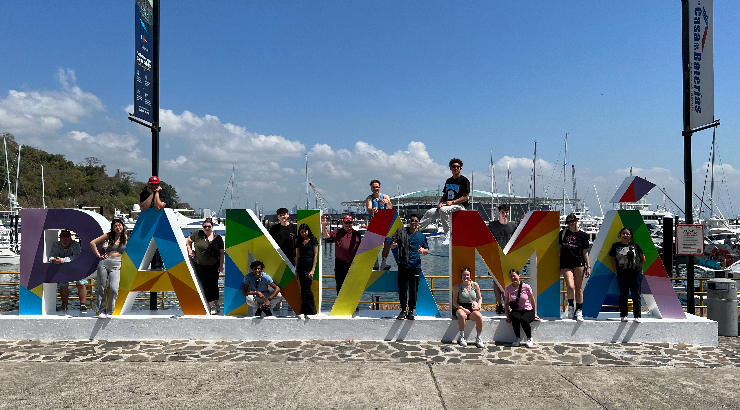
Travel With Argyros: Panama & Costa Rica – Spring Break ’23 Professor Murray's Business Across Cultures (BUS 486) class flew from LAX to Panama City, Panama, and then to San José, Costa Rica
May 9, 2023
For Spring Break 2023, Argyros School students immersed themselves in the challenges and opportunities of doing business in Panama & Costa Rica. After 12 hours of intensive classroom preparation in February 2023, Professor Murray’s Business Across Cultures (BUS 486) class flew from LAX to Panama City, Panama, and then to San José, Costa Rica. The travel experience featured corporate visits with industry leaders and cultural excursions.
Dr. Noel Murray, Director of the Schmid Center for International Business, and Marshall Toplansky, Assistant Professor of Management, accompanied the BUS 486 Business Across Cultures students on this trip. The following is a sample of student reflections:
Classroom Coverage
Cloe Johnson described how the classroom coverage prepared her for the local business culture: “Before our travel to Panama and Costa Rica, we dedicated time to studying business across cultures in a classroom setting. During this learning phase, we examined two approaches to studying culture: emic and etic. The etic approach strives to be culturally neutral and is commonly used by scientists to describe cultures. Once we had gained a foundational understanding of the culture in these two countries, we could take on an emic approach, which involves direct observation. Throughout our travels, we had the opportunity to immerse ourselves in the culture of Panama and Costa Rica by having local interactions, listening to speakers during corporate visits, and engaging in cultural excursions.”
First Stop: Panama
The first stop was Panama City. “During our guided tour of the city,” recalled Damien Lemagnen, “I shopped in the old town and tried some traditional food. The city has a mix of modern skyscrapers and historic landmarks. This mix of old and new represents the culture of Panama, where traditional values coexist with modernization.”
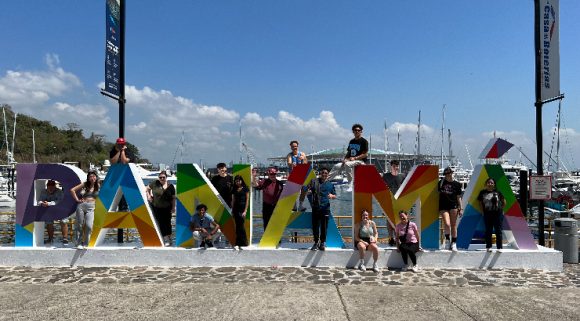
BUS 486 students arrive in Panama
Cultural Experiences: The Embera Community
“Visiting the Embera community was a highlight, and I found their culture fascinating as it contrasted with Panama City’s urban environment. During our visit, we learned that the older generation hopes their children will pursue education in the city and return to the tribe with that knowledge. This hope reminded me of what we learned in class that Panama is a communitarian culture. Communitarianism is about cooperation, social concern, altruism, and public service. The hope is that tourism will bring in income to the community, and children can go to school, get educated and then return to educate the community,” said Cloe Johnson.
Mark Reiland also spoke glowingly of the visit to the Embera indigenous community. “One of the highlights of our visit to the Embera was getting traditional temporary tattoos made with ink from a fruit called jagua. We all got amazing tattoos; they were all very talented artists. We also had a chance to buy some handmade goods, such as baskets, necklaces, bracelets, and hand-carved wooden sculptures. The village was not just a tourist attraction, but a genuine encounter with fascinating people.”
“Overall, spending a day with the Embera was a memorable and eye-opening experience that allowed me to glimpse into the rich cultural heritage of Panama’s indigenous peoples,” said Ohm Patel.
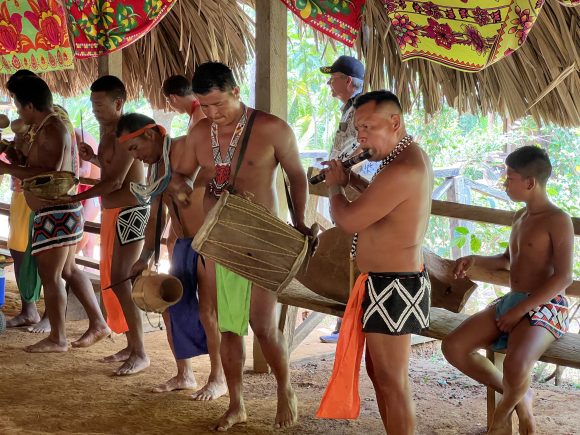
Traditional music performance by the Embera Community
The Panama Canal
Next, students visited one of the centerpieces of the global logistics supply chain, the Panama Canal. “I studied the Panama Canal in high school, and to see it in person was awesome,” said Dominik Firmani. Mark Reiland added, “We saw a cargo ship lowered through the locks, which was really cool. Even being there in person, it is still hard to appreciate the scale of it all.”
Close by, the group visited with Michael Chen, Vice President of the Colón Chamber of Commerce. “Colón is a critical center of global trade, with significant opportunities for growth and development. However, challenges include geo-political competition between American and Chinese container businesses, internal competition among provinces, and negative attention from drug trafficking and money laundering. Despite these challenges, there are opportunities for growth, including aquaculture, American energy, and Canada mining,” according to Dominik Firmani.
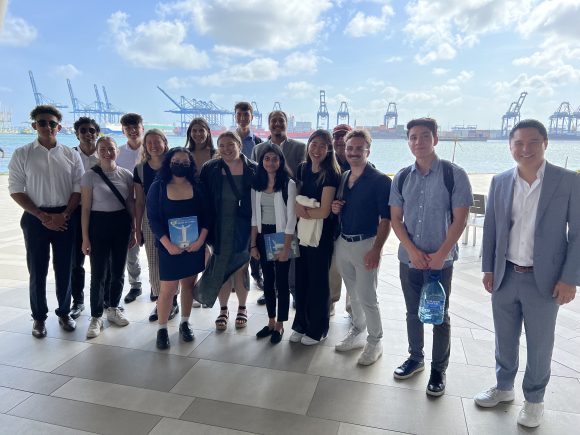
Students with Michael Chen, Colón Chamber of Commerce
Corporate Visits in Panama
Next was a visit to startup Boxit, located in the City of Knowledge, previously a U.S. military base. “Boxit makes white-label community delivery boxes and software. We got to talk with their President, Frank Terrientes, about doing business in Panama and the Americas.” Dominik Firmani recalled that the Boxit case study showed the “logistical difficulties associated with e-commerce in Panama and the opportunity for overcoming them by employing private postal services. The case study also explores the difficulties of breaking into emerging markets like Brazil and the distinctions between B2C and B2B marketing.”
On the final day of corporate visits in Panama, the class met Kenneth Delvalle from the U.S. Commercial Service. Delwalle works with U.S. companies that want to do business in Panama. “He explained how they help them with various services, such as finding potential partners, conducting market research, and organizing trade events. He also shared some success stories of U.S. companies that have benefited from their assistance” said Mark Reiland.
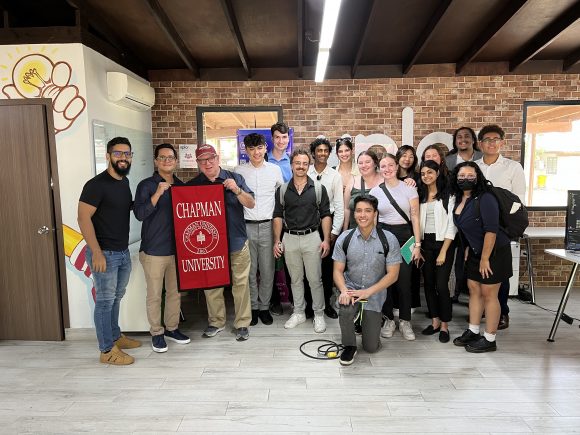
BUS 486 students with Frank Terrientes, President of Boxit
Philips Panama
During a corporate visit to Philips Global Service Center, students heard from Alberto Cos about the growing significance of Artificial Intelligence (A.I.) and how tools like ChatGPT can benefit businesses. “This increased focus on technology is evident in Panama’s thriving tech startup scene and established companies like Philips, which are driving innovation and growth in the sector,” according to Cloe Johnson.
Luke Boctor recalled, “Our final meeting in Panama was held at Philips, where our presenters explored Panama’s transformation into the digital age. The first presenter discussed how Philips uses automation to increase efficiency, reduce time, and create opportunities for value-added tasks. The company is working on chatbots for its websites and has developed the ‘Bot Squad Program,’ where members review ideas, and successful ideas can generate significant time savings. Philips has also been using PowerBI, a tool similar to Excel but better suited for automation. The company is hosting events to train employees using chatbots, which results in reduced training times and cost savings. Natural Language Processing is another technology that Phillips is using to create a digital human that is available 24/7 to answer questions, provide product support, and enhance the purchase experience.”
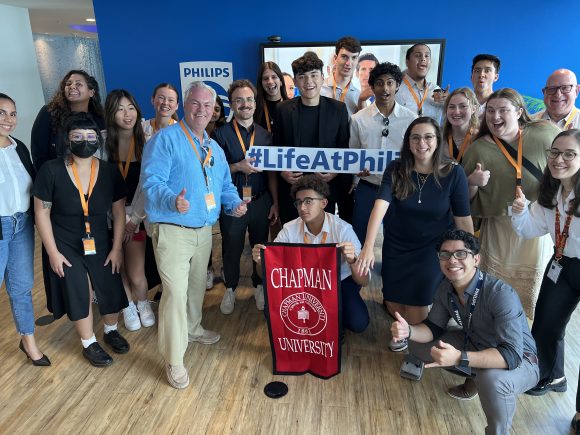
Philips Global Service Center in Panama City
—
Damien Lemagnen summarized the key Panama takeaways: “Panama has numerous opportunities for businesses to develop and prosper. For companies wishing to develop into the Latin American market, the nation’s strategic location, as well as its infrastructure and logistics capabilities, make it the perfect option. Nonetheless, there are difficulties involved with conducting business in Panama. Enterprises may encounter corruption and a lack of educational and employment prospects; however, the pros outweigh the cons. Companies like Philips have shown the nation’s dedication to innovation and sustainable growth. Panama offers enormous economic growth and expansion potential and will remain desirable for global firms.”
Second Stop: Costa Rica
Zoe Mazakas summed up the next stop, Costa Rica, with the local expression “Pura Vida – pure life – describing Costa Rica’s endeavor for simplicity and recognition of the beauty in life. More than just a saying, it represents a way of life for those that live and thrive in Costa Rica. While personal life may be “pura vida,” business is more complex.”
Wednesday was the transfer day, with a brief flight from Panama City to San José. The following day it was back to work with corporate visits.
First up was CINDE, the Costa Rican Investment Promotion Agency. Students met Pablo Lizano, the project portfolio lead. “He gave us a fascinating presentation about how Costa Rica attracts and supports international companies to invest and operate in their country. Pablo explained that Costa Rica had invested much in their education system, especially science, and technology. This investment has resulted in a highly skilled and bilingual workforce that can handle complex and innovative tasks. He contrasted this with Panama, which has a lower level of education and skills among its workers, and with Columbia, which has a talented workforce but doesn’t speak English,” said Mark Reiland.
Luke Boctor noted, “Another key advantage of investing in Costa Rica is its unique multinational company culture, with diverse specialized talent and expertise available in different sectors. Costa Rica also has a conducive ecosystem for increasing productivity. Its location makes it an ideal gateway for reaching America and the world (though Panama has a better location for logistics due to the Panama Canal.) Costa Rica offers tax incentives for foreign direct investment dependent on hiring over one thousand people.”
Hacienda Alsacia: A Starbucks Coffee Farm and Research Center
Next, the group visited the Starbucks Coffee farm, Hacienda Alsacia, at the foot of a spectacular volcano, Poas. It is the only coffee farm in the world that Starbucks owns and has become its global agronomy headquarters. Students had an opportunity to learn about the life cycle of coffee: from the plantation to your home by viewing the working tree nursery, wet mill, drying patio, and roaster. Students witnessed firsthand how the company uses sustainable practices to promote local farmers and continue innovating the art of coffee. Zoe Mazakas noted, “Starbucks serves other businesses by allowing farmers free access to all the agronomists’ groundbreaking findings, such as innovative soil management practices or disease-resistant plants. This business model serves to aid farmers in developing their businesses in a sustainable manner that promotes profitability, quality, and continuous improvement.”
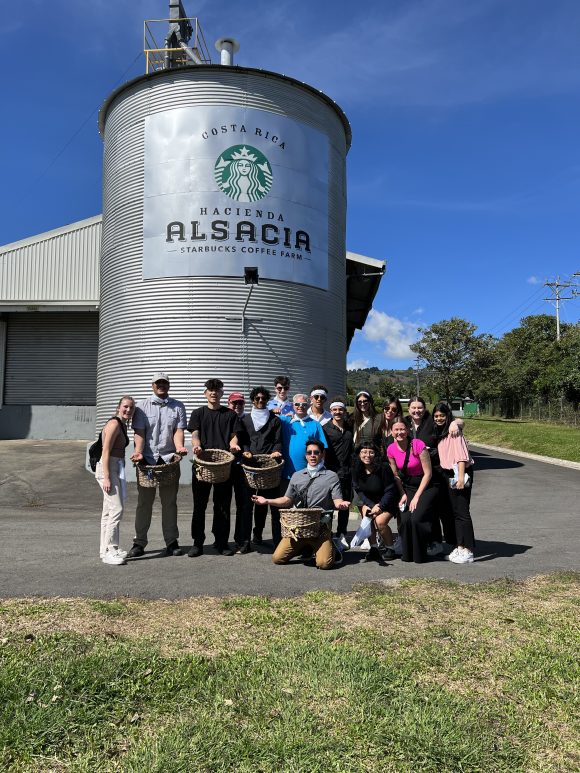
Students visited Hacienda Alsacia: A Starbucks Coffee Farm and Research Center
The Business of Travel & Sustainability
Students also met with Cristina Calvo, who runs two successful businesses in Costa Rica. She is the CMO and partner of Asuaire Travel, a company that offers tailor-made trips to Central America and South America, and the CEO of Green my Experience, which helps businesses reduce their environmental impact. “Cristina shared her story of how she started in the travel business 20 years ago. She faced the challenges of the pandemic that hit the tourism sector hard. Cristina told us how she managed to keep her team motivated and engaged and adapted her services to the new reality. Cristina also explained how she used this crisis to reinvent herself and her businesses and align them with her values and vision. One of the most impressive things we learned from Cristina was how she transformed Asuaire Travel into a carbon-neutral company, meaning they offset all the greenhouse gas emissions generated by their operations and clients’ trips. She said becoming carbon neutral was not as difficult or expensive as expected. There are many ways to reduce the environmental impact of a business. Cristina cited examples, such as switching to LED lighting, installing solar panels, using rainwater for flushing toilets, composting organic waste, recycling paper and plastic, and buying local and organic products. Cristina also highlighted educating their staff and clients about sustainability and measuring and compensating their carbon footprint through certified programs,” recapped Mark Reiland.
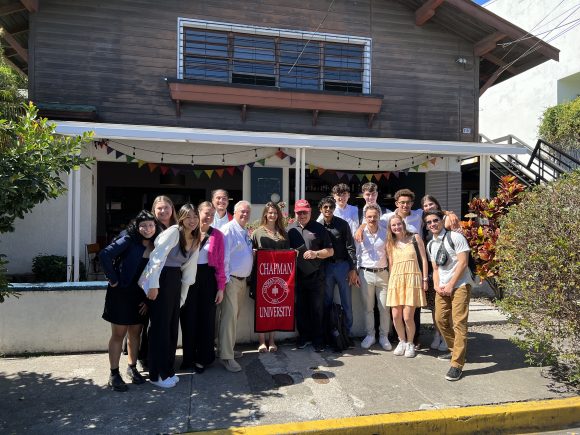
A visit with Cristina Calvo, President of Asuaire Travel
Samina Aziz focused on takeaways on gender issues discussed in the meeting. “We learned about the new advancements in Costa Rica, like striving for equal career opportunities for women. Women in Costa Rica have made numerous advancements legally, in politics, and in the workplace for the past few years. Many Costa Rican women still suffer discrimination, disenchantment, subservience, or worse. Costa Rica is where the tourism development model has extended the benefits of tourism by not centralizing it in just one location. This economic development model allows the benefits of tourism to reach the entire country, including remote areas. Tourism in Costa Rica has provided development opportunities, especially for women, by creating jobs and stimulating the local economy. As a result, it minimizes the need to move to big cities for jobs to earn an income for families.”
__
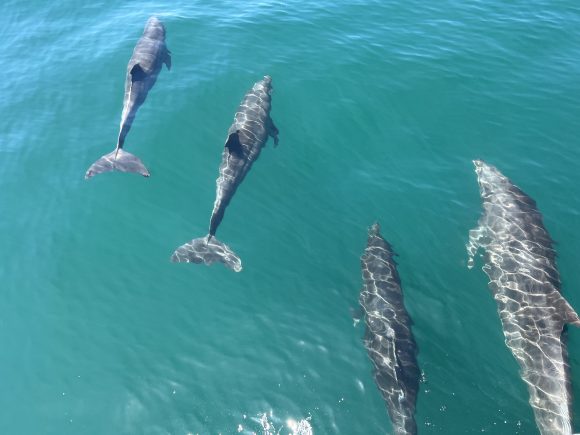
Dolphins swimming alongside the boat in Tortuga Island
The Business Across Cultures group concluded with a little well-deserved R&R in Tortuga Island, which Damien Lemagnen described as “a beautiful island located in the Gulf of Nicoya, off the coast of Costa Rica. The island is known for its pristine beaches, crystal-clear waters, and abundant marine life. While visiting Tortuga Island, I could relax and enjoy the beautiful scenery, reflecting on the country’s natural beauty and tourism potential.”
Maddie Hildebrand concluded, “I am so grateful for this trip and all the memories and experiences I have made. This trip made me realize that I could potentially see myself living in one of these countries and working for a company where I can utilize my business and Spanish language skills.”